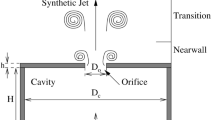Abstract
This paper presents an investigation of ultrahigh pressure waterjet (WJ) flow field with the high-frequency velocity vibration at the nozzle inlet by computational fluid dynamics method. The velocity field of the flow inside the WJ nozzle is obtained. The influence of vibration parameters, such as amplitude and frequency on the flow field are studied. The results of investigation indicate that the flow velocity at the WJ nozzle outlet has almost the same vibrating type with the inlet velocity vibration. During a vibration cycle, the velocity field of the flow is changing greatly. The serials value of the vibration frequency and amplitude are taken to test their influence on the flow field. The simulation results show that the flow field also changes greatly with the different frequency and amplitude. Based on the obtained results, the mechanism of system pressure vibration influence on the water jet flow field inside the WJ nozzle is obtained, and a new method is provided to optimize the machining process with the aim to improve the machine efficiency and surface quality of the work piece.
Similar content being viewed by others
References
Park W, Jang J, Chun H, Kim M (2005) Numerical flow and performance analysis of waterjet propulsion system. Ocean Eng 32:1740–1761
Hashish M (1989) Pressure effects in abrasive waterjet (AWJ) machining. J Eng Mater Technol ASME 111:221–228
Milena K, Michal R, Jan V, Sergej H, Milan K (2012) Determination of technologically optimal factors of modulated waterjet. Int J Adv Manuf Technol 60(1-4):173–179
Ni J (1991) The basic theory of solid-liquid two-phase flow and their new application. Technology
Mabrouki T (2000) Numerical simulation and experimental study of the interaction between a pure high-velocity water jet and targets: contribution to investigate the decoating process. Wear 239:260–273
Jia M (2002) The study and applicant of former mixing abrasive water jet technology. Master Degree, Shanghai University (In Chinese)
Li H (2009) Fluid flow analysis of a single stage centrifugal fan with a ported diffuser. Eng Appl Comput Fluid Mech 3(2):147–163
Holbeach JW, Davidson MR (2009) An eulerian–eulerian model for the dispersion of a suspension of microscopic particles injected into a quiescent liquid. Eng Appl Comput Fluid Mech 3(1):84–97
Hou RG, Huang CZ, Zhu HT, Zhao QZ (2010) Numerical simulation and experimental investigation of the gas-liquid-solid three-phase flow outside of the abrasive water jet nozzle. Key Eng Mater 431–432:90–93
Hou RG, Huang CZ, Wang J, Feng YX, Zhu HT (2006) Simulation of velocity field of two-phase flow for gas and liquid in the abrasive water jet–nozzle. Key Eng Mater 315–316:150–153
Liu H, Wang J, Kelson N, Brown RJ (2004) A study of abrasive waterjet characteristic by CFD simulation. J Mater Process Technol 153–154:488–493
Gong W, Wang J, Gao N (2011) Numerical simulation for abrasive water jet machining based on ALE algorithm. Int J Adv Manuf Technol 53:247–253
Nanduri M, David G, Thomas J (2002) The effects of system and geometric parameters on abrasive waterjet nozzle wear. Int J Mach Tool Manuf 42:615–623
Vinay S, Somnath C, Sergej H (2011) Multi response optimization of process parameters based on Taguchi-Fuzzy model for coal cutting by water jet technology. Int J Adv Manuf Technol 56(9-12):1019–1025
The Fluent Inc (2008) The user guide of the Fluent 6.3
Author information
Authors and Affiliations
Corresponding author
Rights and permissions
About this article
Cite this article
Hou, R., Huang, C. & Zhu, H. Numerical simulation ultrahigh waterjet (WJ) flow field with the high-frequency velocity vibration at the nozzle inlet. Int J Adv Manuf Technol 71, 1087–1092 (2014). https://doi.org/10.1007/s00170-013-5493-9
Received:
Accepted:
Published:
Issue Date:
DOI: https://doi.org/10.1007/s00170-013-5493-9




